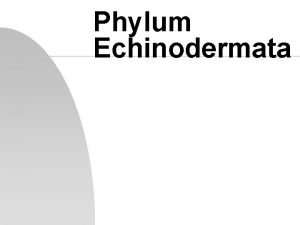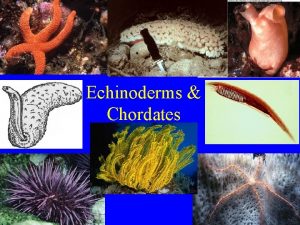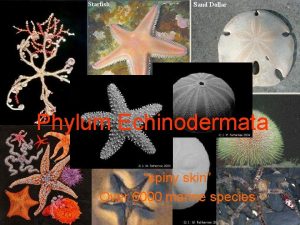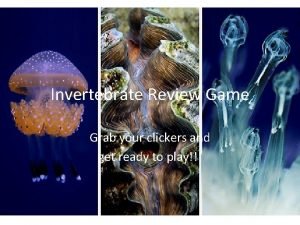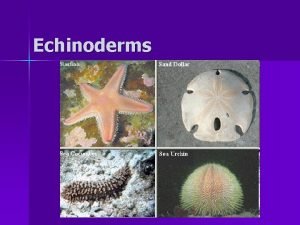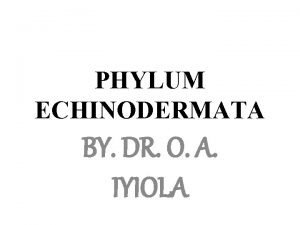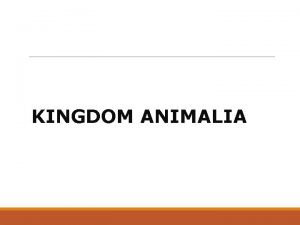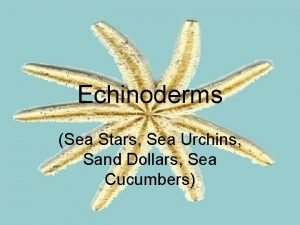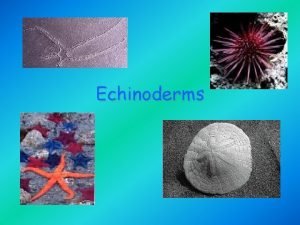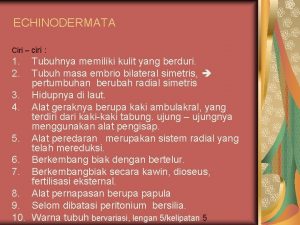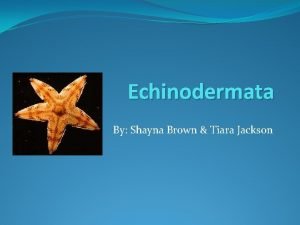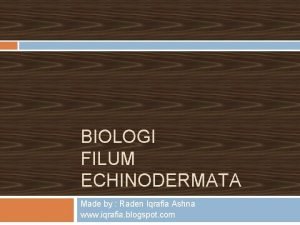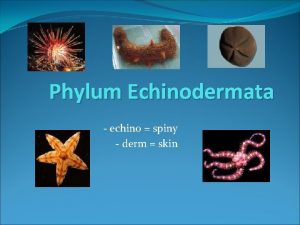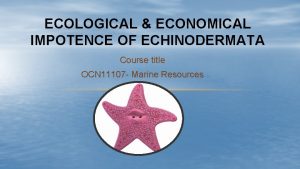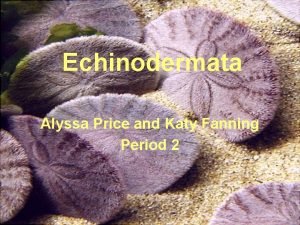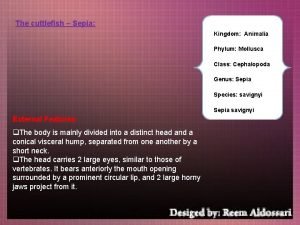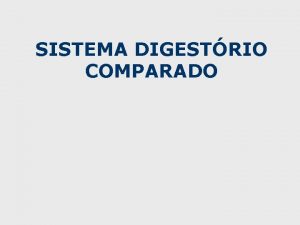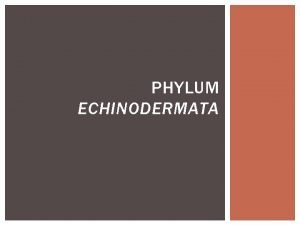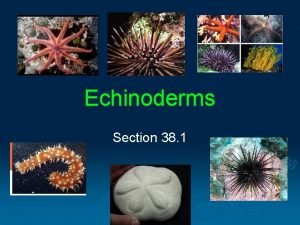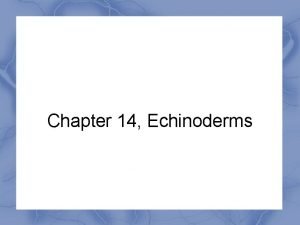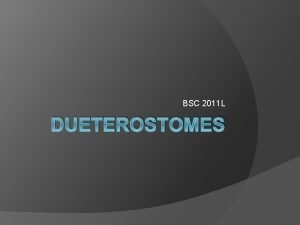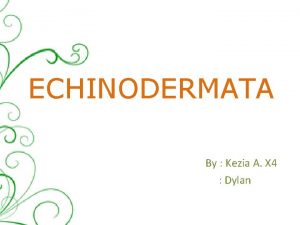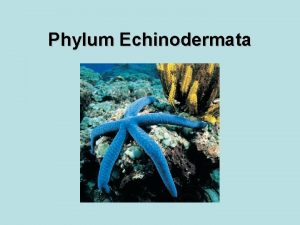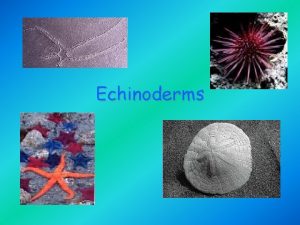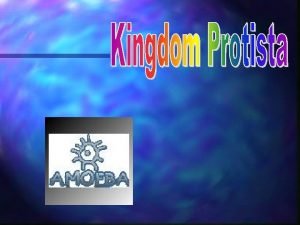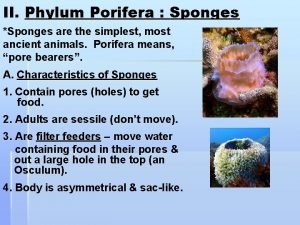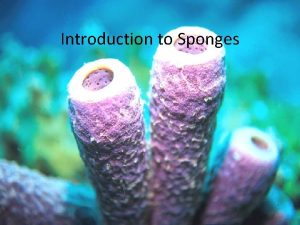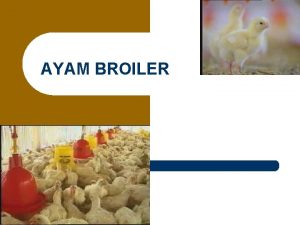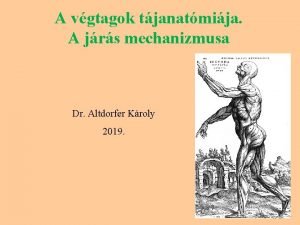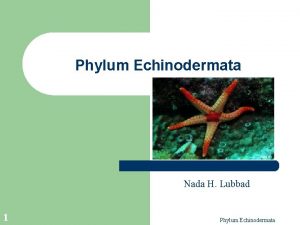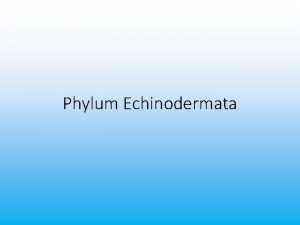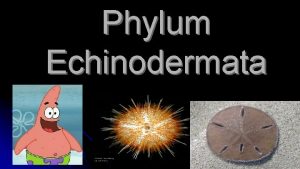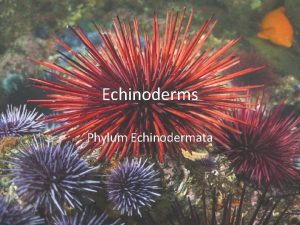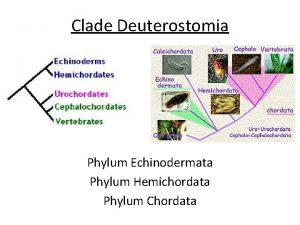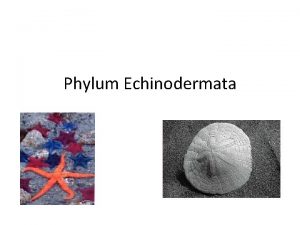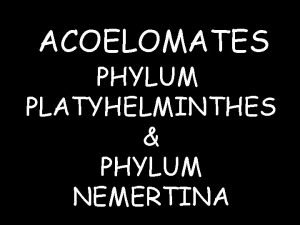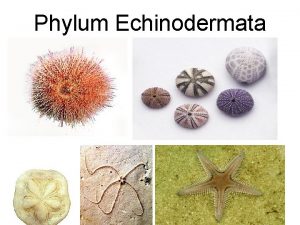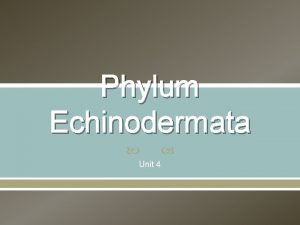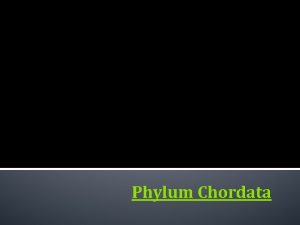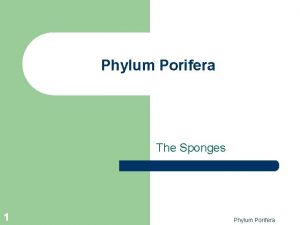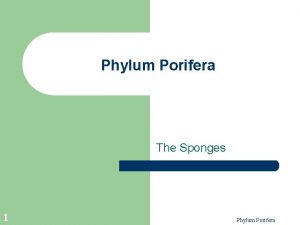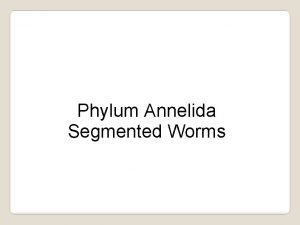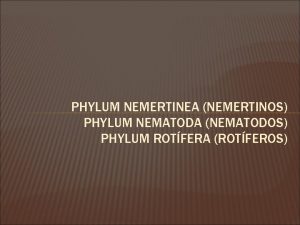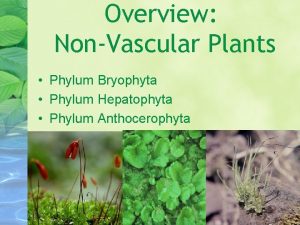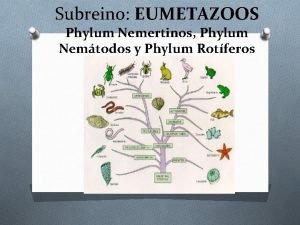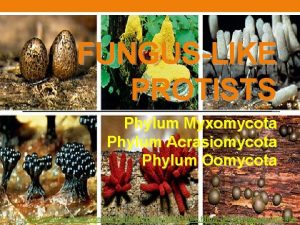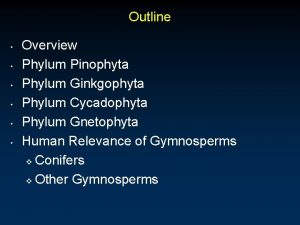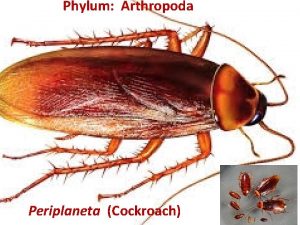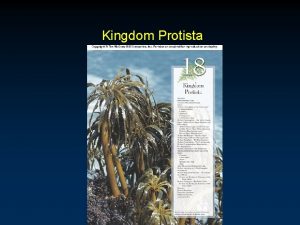Phylum Echinodermata Introduction n n Echinodermata are all




































- Slides: 36

Phylum Echinodermata

Introduction n n Echinodermata are all marine, triploblastic unsegmented coelomates Phylum has 3 unique features: pentagonal symmetry (bilateral in larvae) u calcite spicules embedded in the skin, often partly fused u Tube feet (podia) u

Functional groups 1: nerves n n Echinoderms have a diffuse nervous system with no “brain” There is a 5 -radial circum-oral nerve ring, and a superficial net running close to ectoderm


Hydraulics n n n These are far more complex than the nervous system! Main hydraulic systems are derived from the coelom, although separate sections of the coelom also surround viscera The podia are operated by a hydraulic system called the watervascular system


5 -radial layout n n These rings give rise to 5 radial branches (canals in the case of the WVS) A few asteroids have 7, 10, 11 arms - in which case 7, 10, 11 radial branches

Hydraulics, contd. n n Each radial canal of the WVS supplies water to tube feet, each with its ampulla There is one asymmetric element: a single tube (the “stone canal”) running from the oral WVS ring to the outside via the madreporite


Surface features n Echinoderm skin has several distinctive sets of organs protruding from their skin: u Tube feet (podia) u Spines u Pedicillaria

Tube feet. . They lie in 10 rows (5 pairs), the ambulacral grooves n Each tube foot + its ampulla is isolated from the WVS by a valve n Tube feet vary - starfish have muscular suction cups, other forms have sticky tips.

Tube feet. . n n n These have evolved a highly specialised suction cup used for locomotion and prey capture. Have retractor muscles and can bend, but no extensors To extend, muscles around the ampulla contract



Role of WVS n n n Hydraulics Respiration - O 2 is exchanged between ampulla and perivisceral coelomic fluid Probably (? ) this was the ancestral function of the WVS, with tubes + podia lining arms to exploit ciliary current already used in food collection

Pedicillaria n n …Are defensive organs, assumed to protect against encrusting organisms Are active, independent local effector units able to inject toxins on contact


Madreporite n n Allows pressure equalization and top up water supply to the WVS Is absent in crinoids


Gonads n n n Lie as 10 (2 N) paired structures at the base of ambulacral grooves. Sexes are separate, and discharge gametes into the sea water Gonads can be large - echinoid gonads almost fill the test, and can be eaten as a delicacy.



Crinoidea n n n Feather stars & Sea lilies Abyssal filter feeders 5000 fossil spp, 620 living

Crinoidea n n Body made of ossicles 10 arms have podia (no ampullae) feeding particles to the mouth. Arms can move Mouth and anus are both on oral side (!)


Asteroidea n n “Starfish” Active predators feed on bivalves u use suction cups to pull open the shells with forces of up to 5 kg u n The stomach is eversible, and can be partially inserted inside prey’s shell (enzymes but no toxins)



Echinoidea n n n Recipe: take a starfish and roll its 5 arms together into a ball, then fuse and calcify with an external armor The armor is called the test Very small aboral surface

Echinoidea n n n Herbivores, preferring macro-algae They can be highly effective grazers, creating “urchin barrens” devoid of algae The mouthparts are unique, known as Aristotle’s Lantern. 5 continually growing chisel teeth u Each tooth with 8 supporting skeletal pieces u


Ophiuridae - brittle stars n n n Have arms sharply demarcated from the body disc. The internal structure of the arms involves interlocking internal ossicles, confusingly called vertebrae Are primarily detrital or filter feeders, raising their arms in a current to capture particulates


Holothuridae- Sea Cucumbers n n n They have no calcitic skeleton, except for spicules embedded in a leathery skin Most are immobile, and lie on the sea bed rolling back and forth with the swell. Some have limited mobility using their tube feet. Despite retaining 5 -radiate anatomy, they have re-evolved bilateral symmetry along their long axis (the oral-aboral)

Holothuridae n n n They mainly feed on detritus Oxygen exchange is performed using gills inside their anus They have 2 odd defensive strategies: u Squirting a sticky goo u Voiding their entire intestines

 Insidan region jh
Insidan region jh Brittle stars phylum
Brittle stars phylum Echinodermata
Echinodermata Spiny skin
Spiny skin Asexual reproduction of budding
Asexual reproduction of budding Phylum echinodermata facts
Phylum echinodermata facts Class crinoidea characteristics
Class crinoidea characteristics Name
Name Coelenterata
Coelenterata Sand dollar mouth
Sand dollar mouth Echinodermata means
Echinodermata means Ophiuroidea berkembang biak secara
Ophiuroidea berkembang biak secara Body cavity of echinoderms
Body cavity of echinoderms Ciri echinodermata
Ciri echinodermata Spiny skeleton
Spiny skeleton Economic importance of echinoderms
Economic importance of echinoderms Echinodermata germ layers
Echinodermata germ layers Phylum of cuttlefish
Phylum of cuttlefish Slidetodoc
Slidetodoc Mollusca endoskeleton
Mollusca endoskeleton Holothuroidea examples
Holothuroidea examples Class ophiuroidea characteristics
Class ophiuroidea characteristics Echinodermata
Echinodermata Sistem saraf echinodermata
Sistem saraf echinodermata Holothuroidea
Holothuroidea Echinodermata
Echinodermata Protophyta characteristics
Protophyta characteristics Characteristics porifera
Characteristics porifera Spider phylum
Spider phylum Spongoceol
Spongoceol Help ever hurt never
Help ever hurt never Interventi sociali rivolti all'infanzia e all'adolescenza
Interventi sociali rivolti all'infanzia e all'adolescenza Crucified rejected and alone
Crucified rejected and alone I work all night
I work all night All to one reduction
All to one reduction Sistem all in all out
Sistem all in all out Guyon csatorna
Guyon csatorna

